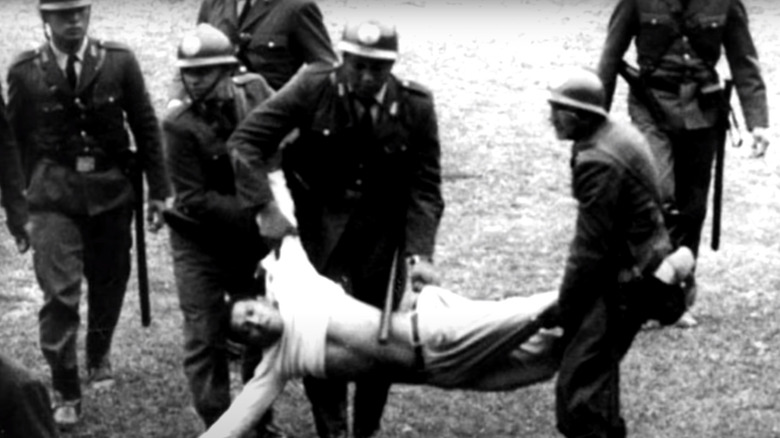The Story Of The The Deadliest Soccer Match In History, Peru Vs. Argentina In 1964
In the United States, fan violence at sporting matches is generally limited to vandalism following an important win or loss. While fans have been known to tear down goalposts on the football field or riot in the streets, rarely do they direct their ire toward one another — instead, they focus on property crime (via the U.S. Department of Justice). And when they go after each other, it's generally limited to fisticuffs as opposed to outright murder.
Outside of North America, however, things can be a bit different. In particular, soccer fans in Europe are legendary for their violence, as are fans in South America. Compounding the problem is that crowd control is an inexact science under the best of circumstances, and trying to herd tens of thousands of people to where you want them (or away from where you don't want them) is sometimes going to result in stampedes and crowd surges. Add some inept policing to the mix, and the problem is only going to be amplified.
Such was the case in 1964 when a blown call during a game between Argentina and Peru set into motion a series of events that ended with more than 300 people killed and 500 people injured, according to History. It was and is the worst soccer-related riot in history.
Setting The Stage
On May 24, 1964, Peru and Argentina were in the midst of qualifying matches for that year's upcoming Summer Olympics (via BBC News). We'll spare you the specifics, but long story short, Peru needed a draw or a win against Argentina to have any hope of advancing. Tens of thousands of fans crowded into Lima's Estadio Nacional (National Stadium) to witness the match. As The Guardian explains, Argentina scored the first goal. As the clock ticked down and Peru's chances deteriorated, a Peru player put the ball into the goal. The game was tied, and the crowd went wild. Except the referee disallowed the goal. "Our player, Kilo Lobaton, raised his foot to block and the ball rebounded into the goal — but the referee said it was a foul, so he disallowed it," Peru player Hector Chumpitaz told BBC News.
An angry fan ran onto the field, then another. Police promptly removed the first from the field, but the second fan, Edilberto Cuenca, didn't fare so well: Police, who can most charitably be described as "overzealous," beat him within an inch of his life, angering the crowd even further. And then things got worse.
The Aftermath
Enraged by the blown call and subsequent overzealous policing of the fans who breached the pitch, fans in the stands started hurling projectiles onto the field, and more were trying to get onto the playing surface (via the BBC). It was then that fan Jose Salas and his companions decided that it was time to get out of the stadium. Only they couldn't: the exit gate was closed. As they tried to move to another exit, police started deploying tear gas, causing a mass of fans to try to leave at once. Unfortunately, the stadium wasn't equipped to handle so many people at once, and the mob found itself stuck. Salas speculates that he was caught in the crowd for two hours, unable to move and at times unable to even touch the ground. Several fans died of asphyxiation.
Outside the stadium, things were barely better. Those fans that managed to escape soon found themselves in a battle against armed police. "Then the shooting began, and they started running. The shots were outside — bullets were everywhere," Salas said (per the BBC). Eventually, Lima police managed to get control of the beleaguered city. When the dust had settled, 328 people were dead, although the death toll may even be higher since the figure doesn't include the number of victims killed by gunfire.


